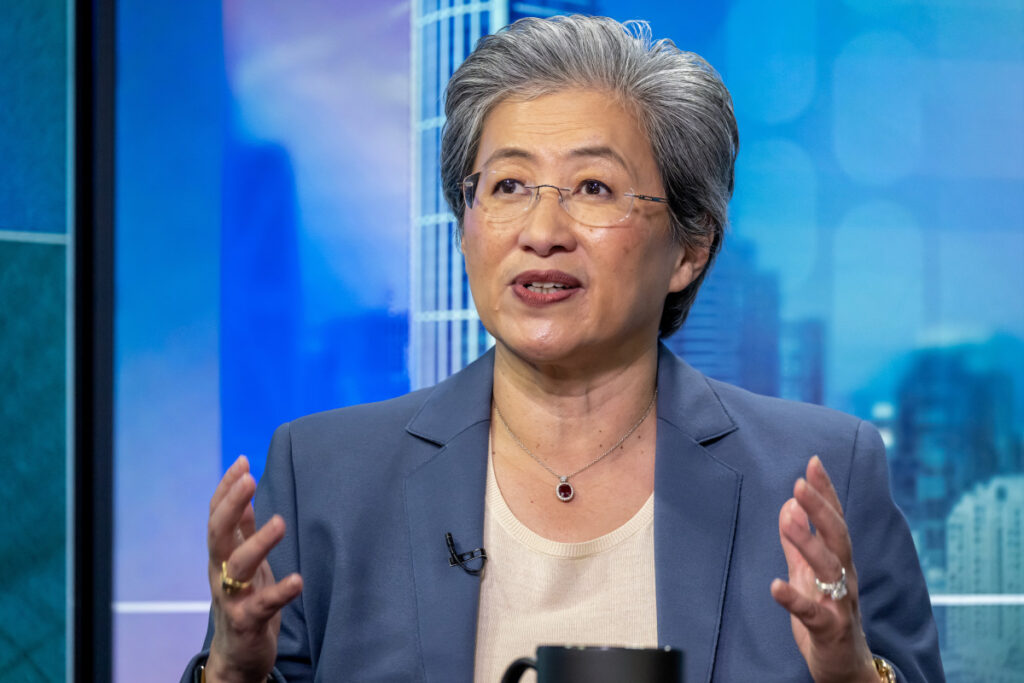Wall Street just gave Advanced Micro Devices a big vote of confidence. After AMD made a huge deal with OpenAI that could bring in $100 billion in revenue over the next few years, Bank of America Global Research raised its price target for the chipmaker to $250; a big move.
“OpenAI is arguably the most disruptive of GenAI cloud computing customers… its success is likely to act as a force multiplier for other cloud vendors and LLM providers to accelerate their capex, positive for multiple chip, memory, optical, networking, and foundry suppliers.”
Bank of America, also known as BofA, now thinks that AMD will rake in more than $15 per share in earnings by 2030. This is a big change from their previous estimate, and was driven by the chipmaker’s deal to provide OpenAI with 6 gigawatts of AI computing power starting in late 2026.
Bloomberg/Getty Images
The deal gives OpenAI performance-based warrants to buy up to 160 million AMD shares, with tranches vesting if AMD stock reaches milestones as high as $600 per share.
AMD joins elite AI circle with OpenAI deal
Arya thinks this partnership makes AMD a serious long-term competitor to Nvidia in the AI compute race. AMD’s rack-scale Helios architecture and MI450X GPUs seem to be gaining ground, even though Nvidia is still in charge.
More AI Stocks:
- Palantir lands surprise AI deal with 109-year-old titan
- Nvidia’s deal with OpenAI ‘looks a lot like financial theater’
- Nvidia spending billions to spread its AI dominance
AMD has long been seen as playing catch-up in the high-stakes GPU arms race, but this partnership is a big step forward for the company. BofA thinks AMD’s position is getting stronger because demand for other AI silicon is rising quickly and the company can deliver on a large scale.
AMD’s win is important due to the deal’s size and structure, but Nvidia and Broadcom remain buy-rated. The situation is a classic “a rising tide lifts all boats,” thanks to the huge amounts of money that OpenAI and its competitors are expected to spend.
Related: The stock market laughed, then Palantir redefined the fight
The research note says that each 1 GW of computing power could bring in about $17.5 billion in revenue, depending on how it is set up. If AMD’s full 6 GW capacity commitment is fully deployed, it could lead to a big increase in earnings, even after taking into account the dilution from OpenAI’s equity stake.
The note also says that this deal is in addition to AMD’s other wins from earlier this year, like sovereign cloud deals in the Middle East.
Wall Street cheers price hike, but risks remain
BofA’s new price target of $250 is based on 33 times the estimated EPS for 2027, which is in line with historical multiples and a PEG ratio of 1.1 times. Before, BofA thought the stock would be worth $200.
The news about OpenAI has sent AMD shares up 43% this week alone, from $148 to over $212. That would be its best weekly performance since 2016.
There is still a risk of execution, especially regarding timelines, power delivery, and product competitiveness. However, Wall Street seems to be getting more and more sure that AMD is not only part of the next wave of AI but is also helping to shape it.
Related: Palantir’s Pentagon dream just hit a classified snag
People are keeping an eye on how OpenAI’s stake in AMD grows, especially since performance-based warrants only vest if AMD stock crosses certain thresholds. This structure strongly aligns long-term incentives.
Big bets on AMD’s future tech roadmap
Analysts are also talking about how the deal is set up.
The fact that the deployment will last for many years, starting in late 2026, shows that OpenAI trusts AMD’s current abilities and future plans for new chips. Analysts say each new generation of chips and racks could unlock more value, potentially shifting customers away from Nvidia as they hedge their AI bets.
People are also praising AMD’s technical strategy. The MI450X GPUs and Helios rack-scale architecture show that the company is not only interested in chip performance, but also in providing complete solutions that are optimized for large-scale AI deployments.
“By CY30E, we see EPS Power of up to $15+ at the full 6GW deployment (2GW in CY30E) assumption at 35% EBIT margin and the full 160mn shares added,” Arya wrote.
Related: Electronic Arts buyout may be loudest edge public rivals ever get
So, this might not be a one-time thing. If OpenAI’s growth leads to a new boom in AI infrastructure, AMD could become a key player in the next wave of capital spending from both hyperscalers and sovereign clouds.
AMD is finally taking the offensive against Nvidia, which is trying to keep its huge lead. With OpenAI on its side, the playing field may never be the same again.
Related: Jeff Bezos has hard-nosed take on work-life balance
